Lagrangian Observation of the Kuroshio Current by Surface Drifters in 2019
Abstract
1. Introduction
2. Data and Methods
3. Surface Current Observation
3.1. Overall Trajectories
3.2. Climatological Current Field
3.3. Kuroshio around the Luzon Strait
3.4. Kuroshio Northeast of Taiwan Island
3.5. Kuroshio South of Japan
4. Lagrangian Diffusivity and Integral Scales
5. Summary and Discussion
Author Contributions
Funding
Institutional Review Board Statement
Informed Consent Statement
Data Availability Statement
Conflicts of Interest
References
- Su, J. A review of circulation dynamics of the coastal oceans near China. Acta Oceanol. Sin. 2001, 23, 1–16. [Google Scholar]
- Hu, X.; Xiong, X.; Qiao, F.; Guo, B. Surface current field and seasonal variability in the Kuroshio and adjacent regions derived from satellite-tracked drifter data. Acta Oceanol. Sin. 2008, 27, 11–29. [Google Scholar]
- Zhang, Z.-L.; Nakamura, H.; Zhu, X.-H. Seasonal Velocity Variations over the Entire Kuroshio Path Part I: Data Analysis and Numerical Experiments. J. Oceanogr. 2021, 77, 719–744. [Google Scholar] [CrossRef]
- Zuo, J.; Zhang, M.; Xu, Q.; Mu, L.; Li, J.; Chen, M. Seasonal and Interannual Variabilities of Mean Velocity of Kuroshio Based on Satellite Data. Water Sci. Eng. 2012, 5, 428–439. [Google Scholar] [CrossRef]
- Liu, Z.; Zhu, X.; Nakamura, H.; Nishina, A.; Wang, M.; Zheng, H. Comprehensive Observational Features for the Kuroshio Transport Decreasing Trend during a Recent Global Warming Hiatus. Geophys. Res. Lett. 2021, 48. [Google Scholar] [CrossRef]
- Centurioni, L.R.; Niiler, P.P.; Lee, D.-K. Observations of Inflow of Philippine Sea Surface Water into the South China Sea through the Luzon Strait. J. Phys. Oceanogr. 2004, 34, 113–121. [Google Scholar] [CrossRef]
- Qiu, Y.; Li, L.; Chen, C.-T.A.; Guo, X.; Jing, C. Currents in the Taiwan Strait as Observed by Surface Drifters. J. Oceanogr. 2011, 67, 395–404. [Google Scholar] [CrossRef]
- Guo, J.; Chen, X.; Sprintall, J.; Guo, B.; Qiao, F.; Yuan, Y. Surface Inflow into the South China Sea through the Luzon Strait in Winter. Chin. J. Ocean. Limnol. 2012, 30, 163–168. [Google Scholar] [CrossRef]
- Hsu, P.-C. Surface Current Variations and Hydrological Characteristics of the Penghu Channel in the Southeastern Taiwan Strait. Remote Sens. 2022, 14, 1816. [Google Scholar] [CrossRef]
- Yuan, D.; Han, W.; Hu, D. Surface Kuroshio path in the Luzon Strait area derived from satellite remote sensing data. J. Geophys. Res. Space Phys. 2006, 111, C11007. [Google Scholar] [CrossRef]
- Sheremet, V.A. Hysteresis of a Western Boundary Current Leaping across a Gap. J. Phys. Oceanogr. 2001, 31, 1247–1259. [Google Scholar] [CrossRef]
- Yuan, D.; Wang, Z. Hysteresis and Dynamics of a Western Boundary Current Flowing by a Gap Forced by Impingement of Mesoscale Eddies. J. Phys. Oceanogr. 2011, 41, 878–888. [Google Scholar] [CrossRef]
- Liu, Z.; Gan, J. Variability of the Kuroshio in the East China Sea Derived from Satellite Altimetry Data. Deep. Sea Res. Part I Oceanogr. Res. Pap. 2012, 59, 25–36. [Google Scholar] [CrossRef]
- Ding, R.; Huang, D.; Xuan, J.; Mayer, B.; Zhou, F.; Pohlmann, T. Cross-Shelf Water Exchange in the East China Sea as Estimated by Satellite Altimetry and in Situ Hydrographic Measurement. J. Geophys. Res. Ocean. 2016, 121, 7192–7211. [Google Scholar] [CrossRef]
- Wang, J.; Oey, L.Y. Seasonal Exchanges of the Kuroshio and Shelf Waters and Their Impacts on the Shelf Currents of the East China Sea. J. Phys. Oceanogr. 2016, 46, 1615–1632. [Google Scholar] [CrossRef]
- Liu, X.; Dong, C.; Chen, D.; Su, J. The Pattern and Variability of Winter Kuroshio Intrusion Northeast of Taiwan. J. Geophys. Res. Ocean. 2014, 119, 5380–5394. [Google Scholar] [CrossRef]
- Zhou, F.; Xue, H.; Huang, D.; Xuan, J.; Ni, X.; Xiu, P.; Hao, Q. Cross-Shelf Exchange in the Shelf of the East China Sea. J. Geophys. Res. Ocean. 2015, 120, 1545–1572. [Google Scholar] [CrossRef]
- Hsu, P.; Centurioni, L.; Shao, H.; Zheng, Q.; Lu, C.; Hsu, T.; Tseng, R. Surface Current Variations and Oceanic Fronts in the Southern East China Sea: Drifter Experiments, Coastal Radar Applications, and Satellite Observations. J. Geophys. Res. Ocean. 2021, 126, e2021JC017373. [Google Scholar] [CrossRef]
- Lu, C.-Y.; Hsu, P.-C.; Zheng, Q.; Ho, C.-R. Variations in Flow Patterns in the Northern Taiwan Strait Observed by Satellite-Tracked Drifters. Remote Sens. 2022, 14, 2154. [Google Scholar] [CrossRef]
- Kawabe, M. Variations of Current Path, Velocity, and Volume Transport of the Kuroshio in Relation with the Large Meander. J. Phys. Oceanogr. 1995, 25, 3103–3117. [Google Scholar] [CrossRef]
- Ambe, D.; Imawaki, S.; Uchida, H.; Ichikawa, K. Estimating the Kuroshio Axis South of Japan Using Combination of Satellite Altimetry and Drifting Buoys. J. Oceanogr. 2004, 60, 375–382. [Google Scholar] [CrossRef]
- Sugimoto, S.; Qiu, B.; Kojima, A. Marked Coastal Warming off Tokai Attributable to Kuroshio Large Meander. J. Oceanogr. 2020, 76, 141–154. [Google Scholar] [CrossRef]
- Wang, Q.; Tang, Y. The Interannual Variability of Eddy Kinetic Energy in the Kuroshio Large Meander Region and Its Relationship to the Kuroshio Latitudinal Position at 140 °E. J. Geophys. Res. Ocean. 2022, 127, e2021JC017915. [Google Scholar] [CrossRef]
- Lumpkin, R.; Centurioni, L. Global Drifter Program Quality-Controlled 6-Hour Interpolated Data from Ocean Surface Drifting Buoys; NOAA National Centers for Environmental Information: Boulder, CO, USA, 2019.
- Taylor, G.I. Diffusion by Continuous Movements. Proc. Lond. Math. Soc. 1922, s2–20, 196–212. [Google Scholar] [CrossRef]
- Davis, R.E. Observing the General Circulation with Floats. Deep. Sea Res. Part A Oceanogr. Res. Pap. 1991, 38, S531–S571. [Google Scholar] [CrossRef]
- Lumpkin, R.; Özgökmen, T.; Centurioni, L. Advances in the Application of Surface Drifters. Annu. Rev. Mar. Sci. 2017, 9, 59–81. [Google Scholar] [CrossRef]
- Zhurbas, V.; Oh, I.S. Drifter-Derived Maps of Lateral Diffusivity in the Pacific and Atlantic Oceans in Relation to Surface Circulation Patterns. J. Geophys. Res. 2004, 109, C05015. [Google Scholar] [CrossRef]
- Qian, Y.-K.; Peng, S.; Li, Y. Eulerian and Lagrangian Statistics in the South China Sea as Deduced from Surface Drifters. J. Phys. Oceanogr. 2013, 43, 726–743. [Google Scholar] [CrossRef][Green Version]
- Hansen, D.V.; Poulain, P.-M. Quality Control and Interpolations of WOCE-TOGA Drifter Data. J. Atmos. Ocean. Technol. 1996, 13, 900–909. [Google Scholar] [CrossRef]
- Pujol, M.; Mertz, F. Product user manual for sea level SLA products. Copernic. Monit. Environ. Mar. Serv. 2019, 10, 1–51. [Google Scholar]
- Yu, L.; Xiong, X.; Guo, Y. Analysis of the path and axis features of the Kuroshio at the depth of 15m based on drifting buoy data. Adv. Mar. Sci. 2014, 32, 316–323. [Google Scholar]
- Feng, Y.; Chen, H.; Yuan, Y. Analysis of Argos drifter data for Kuroshio characteristics in East China Sea. Adv. Mar. Sci. 2010, 28, 275–284, (In Chinese with English Abstract). [Google Scholar]
- Nagano, A.; Yamashita, Y.; Hasegawa, T.; Ariyoshi, K.; Matsumoto, H.; Shinohara, M. Characteristics of an Atypical Large-Meander Path of the Kuroshio Current South of Japan Formed in September 2017. Mar. Geophys Res. 2019, 40, 525–539. [Google Scholar] [CrossRef]
- Poulain, P.-M. Adriatic Sea Surface Circulation as Derived from Drifter Data between 1990 and 1999. J. Mar. Syst. 2001, 29, 3–32. [Google Scholar] [CrossRef]
- LaCasce, J.H. Statistics from Lagrangian Observations. Prog. Oceanogr. 2008, 77, 1–29. [Google Scholar] [CrossRef]
- Swenson, M.S.; Niiler, P.P. Statistical Analysis of the Surface Circulation of the California Current. J. Geophys. Res. 1996, 101, 22631–22645. [Google Scholar] [CrossRef]
- Zhang, H.-M.; Prater, M.D.; Rossby, T. Isopycnal Lagrangian Statistics from the North Atlantic Current RAFOS Float Observations. J. Geophys. Res. 2001, 106, 13817–13836. [Google Scholar] [CrossRef]
- Huang, G.; Zhan, H.; He, Q.; Wei, X.; Li, B. A Lagrangian study of the near-surface intrusion of Pacific water into the South China Sea. Acta Oceanol. Sin. 2021, 40, 15–30. [Google Scholar] [CrossRef]

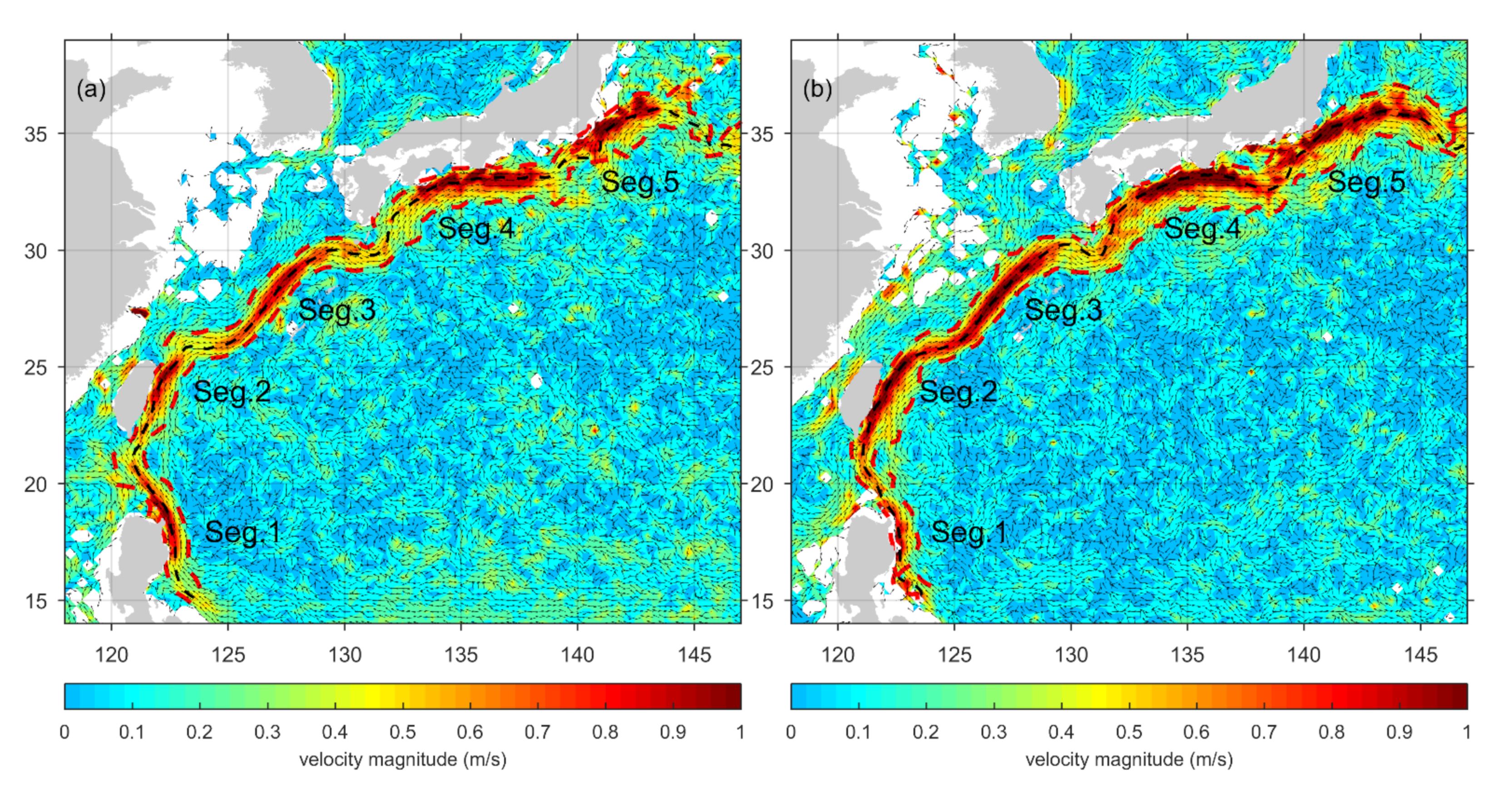
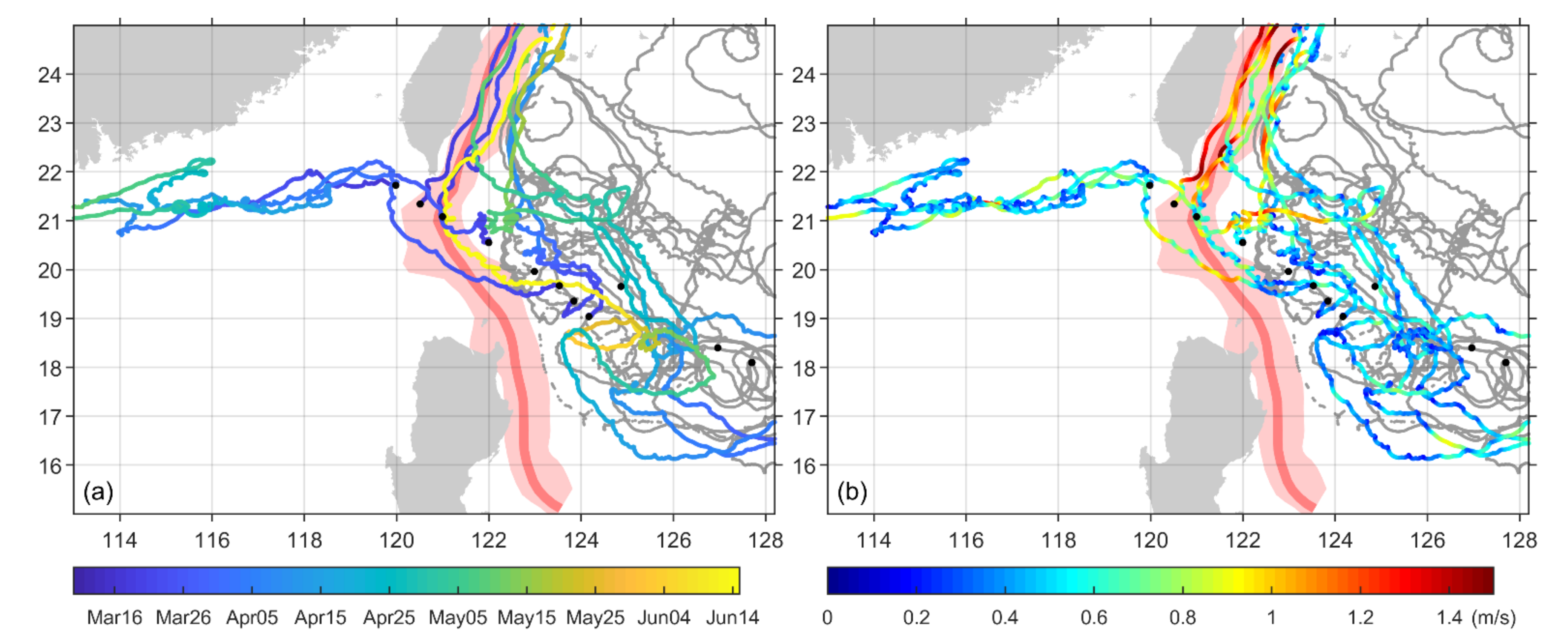
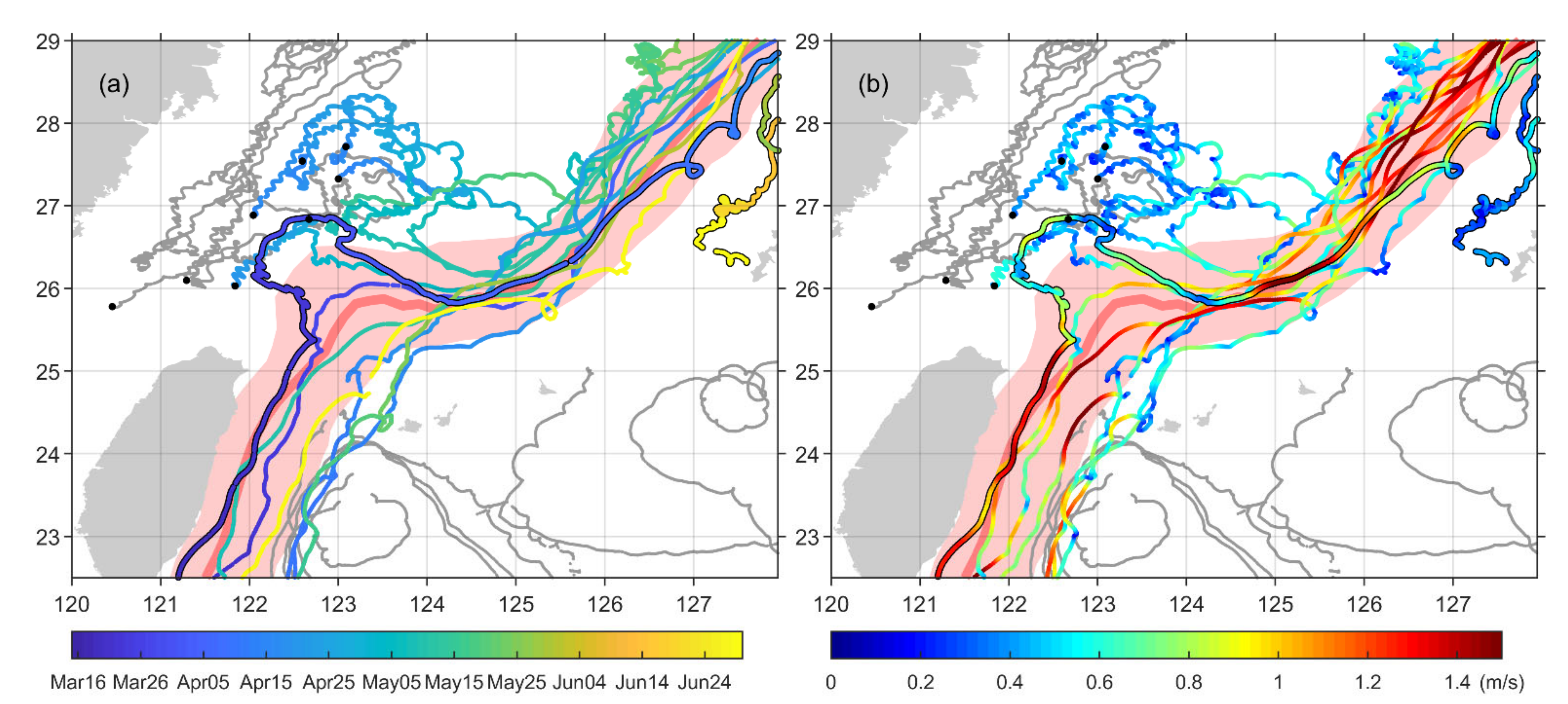
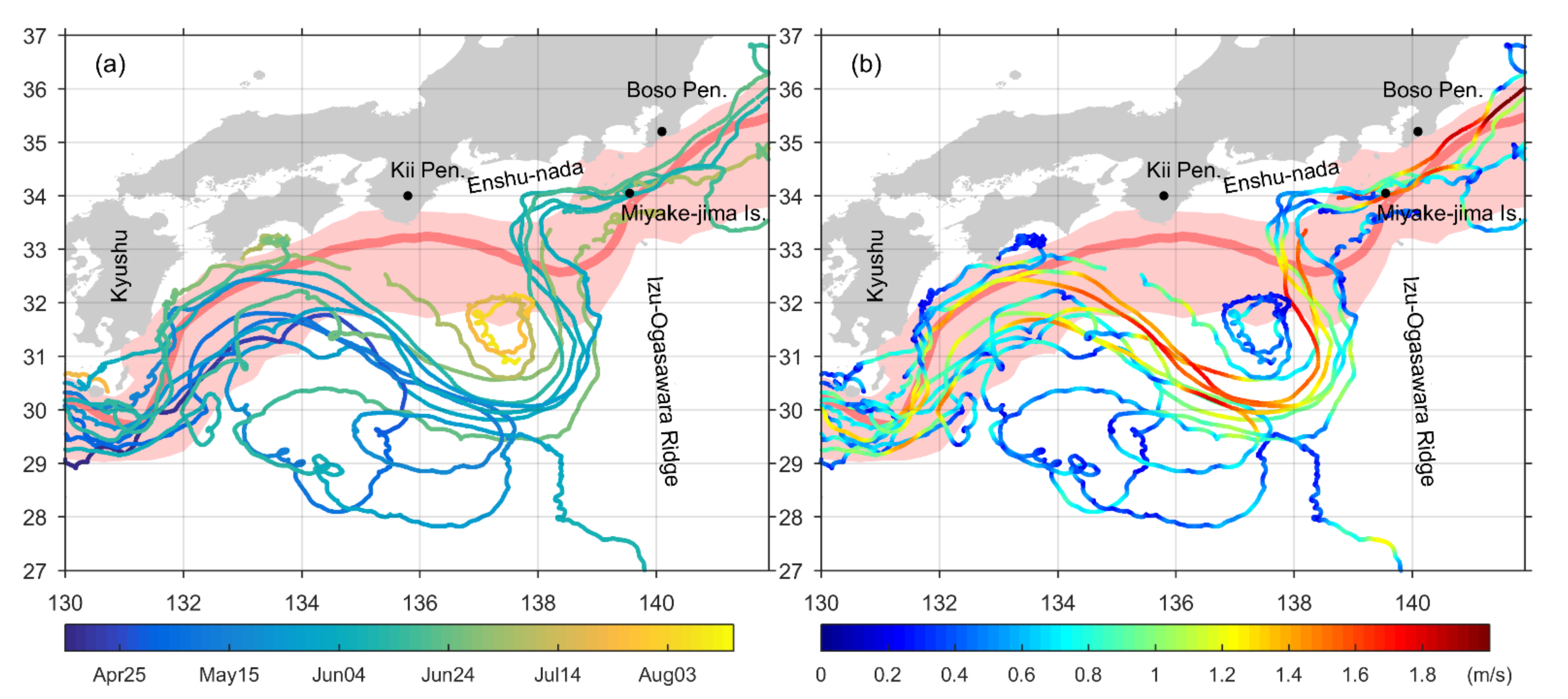
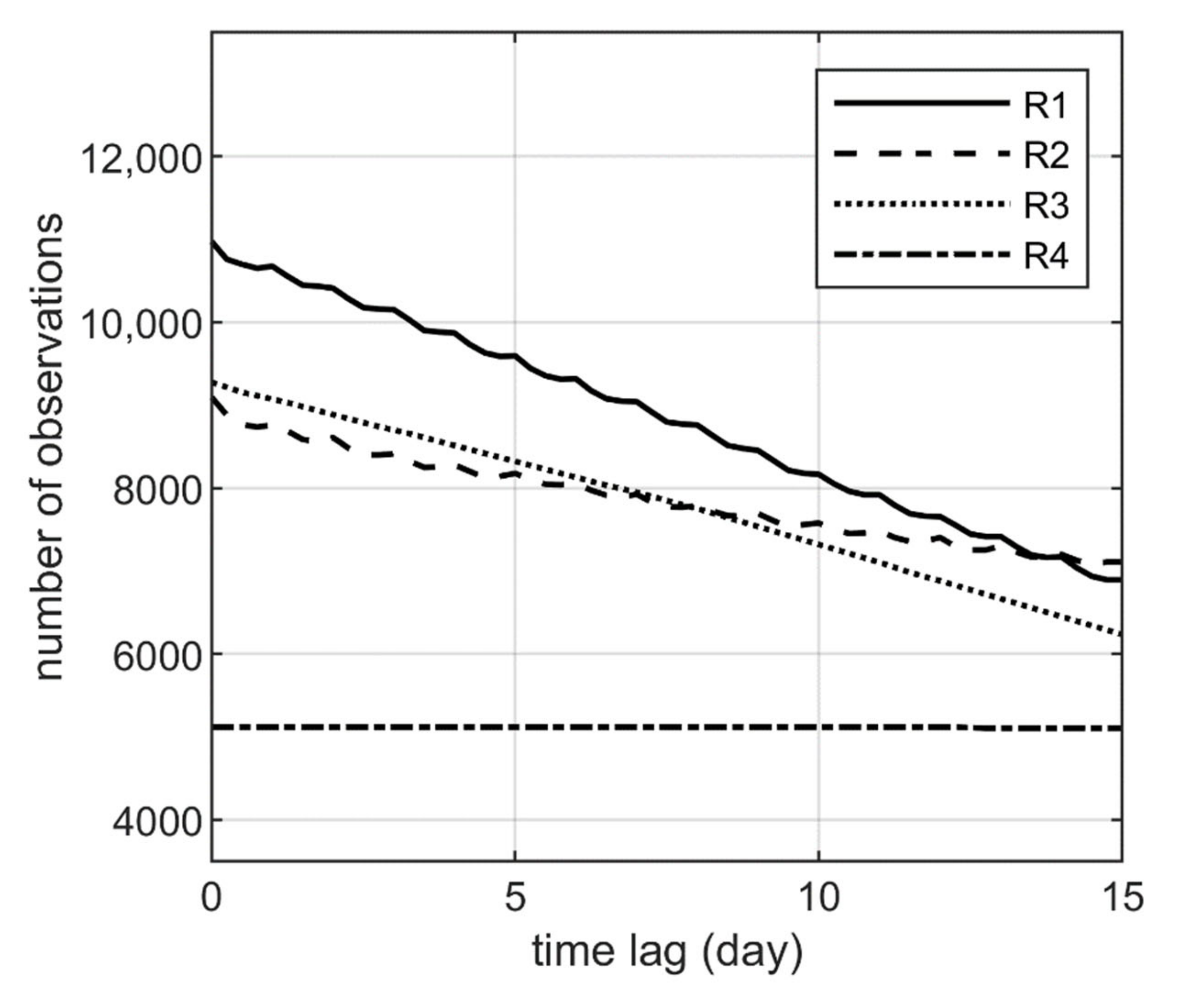
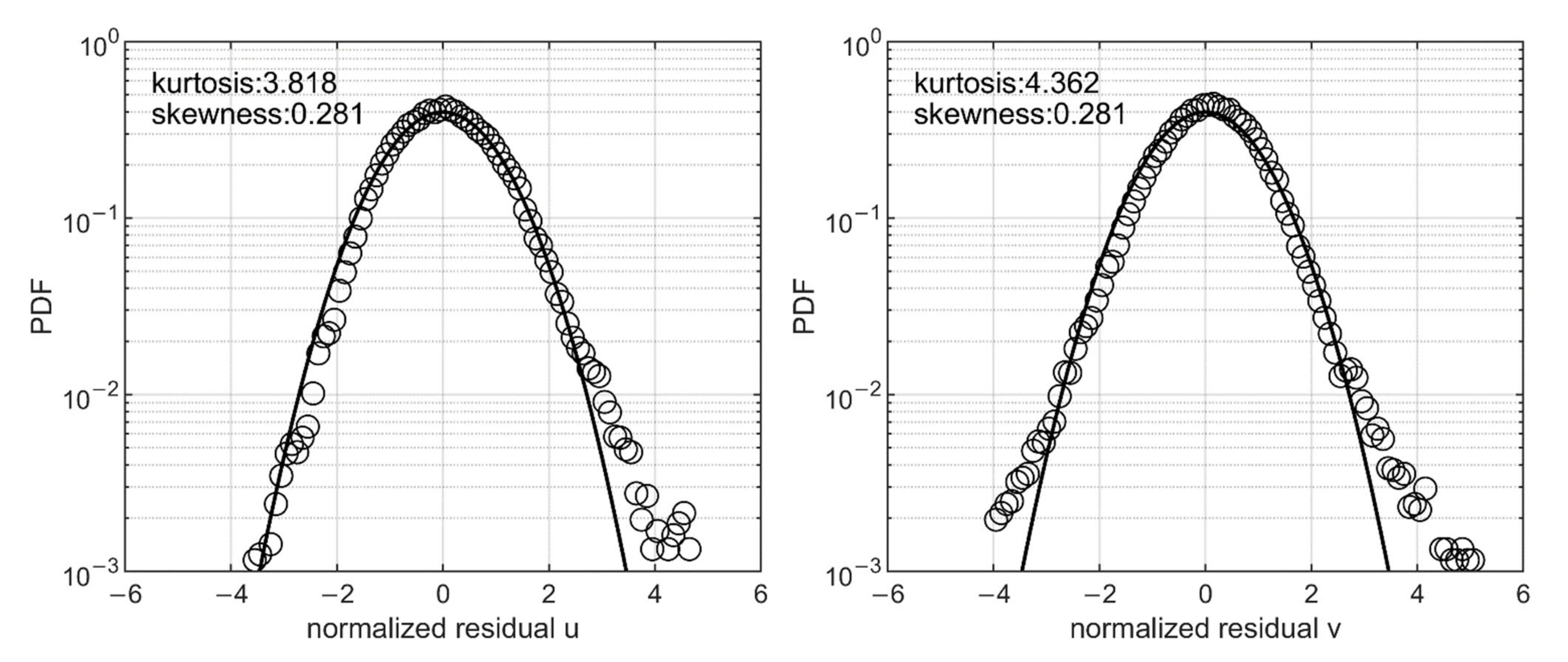
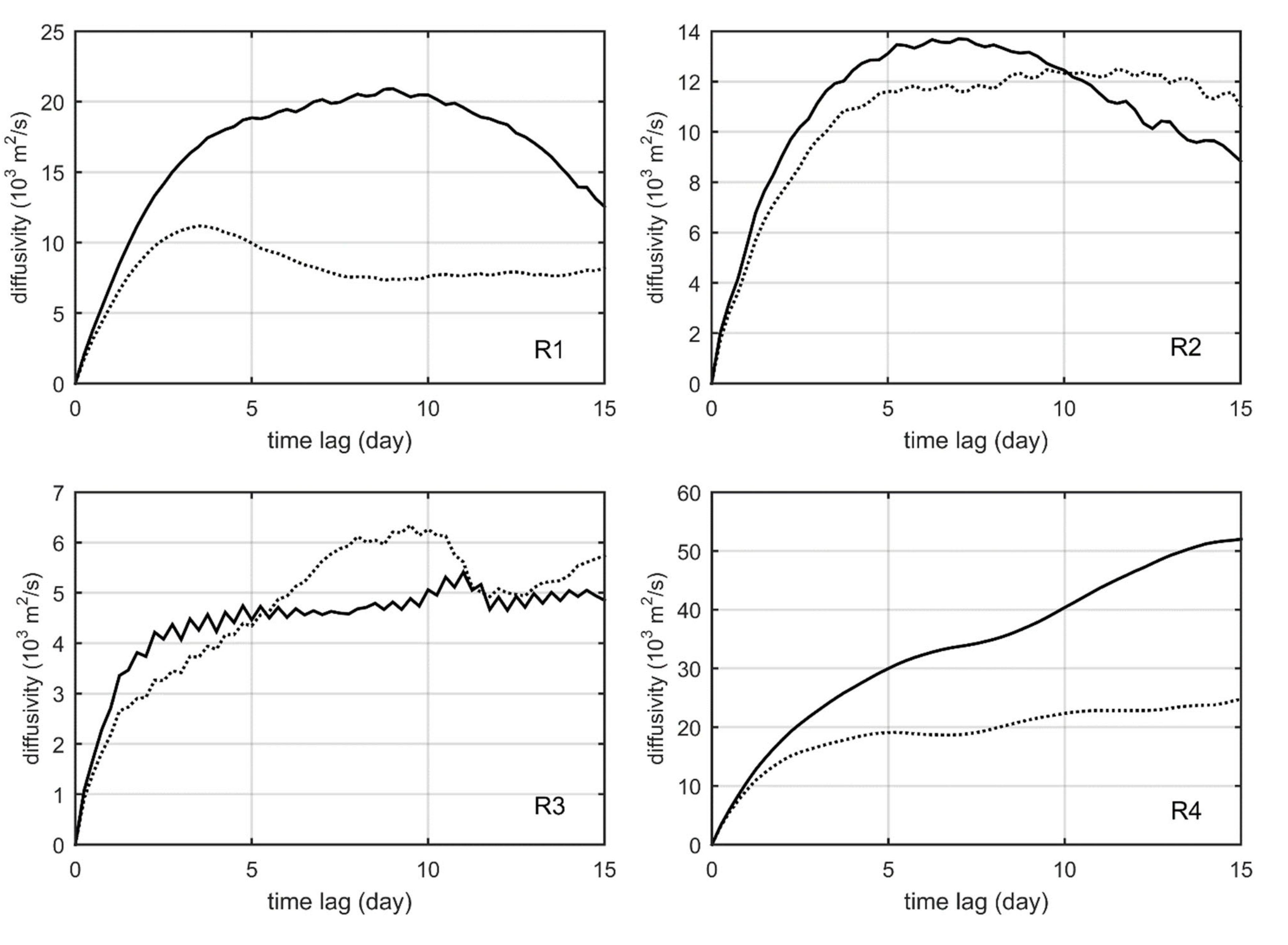
| Drifter ID | Deploy Date | Deploy Longitude ° E | Deploy Latitude ° N | End Date | Deploy Region |
|---|---|---|---|---|---|
| 927675 | 03/16 | 119.9822 | 21.7261 | 10/14 | LS |
| 927739 | 03/16 | 120.5111 | 21.3411 | 07/15 | LS |
| 927666 | 03/17 | 120.9962 | 21.0814 | 07/12 | LS |
| 927674 | 03/17 | 121.9973 | 20.5525 | 05/31 | LS |
| 927665 | 03/17 | 122.9878 | 19.9623 | 03/20 | LS |
| 927692 | 03/17 | 123.5281 | 19.6712 | 07/11 | LS |
| 927676 | 03/18 | 123.8439 | 19.3565 | 07/12 | LS |
| 927723 | 03/18 | 124.1676 | 19.0382 | 07/15 | LS |
| 927689 | 03/19 | 128.4995 | 18.3962 | 06/10 | WP |
| 927734 | 03/19 | 129.5058 | 18.3768 | 07/16 | WP |
| 927733 | 03/20 | 129.8386 | 18.3819 | 07/09 | WP |
| 927687 | 03/20 | 130.1921 | 18.3960 | 07/02 | WP |
| 927691 | 03/20 | 130.5318 | 18.4065 | 07/15 | WP |
| 927693 | 03/20 | 130.8683 | 18.4543 | 07/16 | WP |
| 927668 | 03/29 | 129.5119 | 18.1059 | 07/23 | WP |
| 927670 | 03/30 | 129.0586 | 18.0988 | 07/24 | WP |
| 927731 | 03/30 | 128.6038 | 18.0935 | 07/24 | WP |
| 927679 | 03/30 | 127.7029 | 18.0986 | 04/26 | WP |
| 927690 | 04/14 | 127.6958 | 18.0966 | 08/08 | WP |
| 927720 | 04/16 | 126.9606 | 18.3989 | 08/11 | WP |
| 927738 | 04/17 | 124.8617 | 19.6548 | 08/12 | WP |
| 927718 | 04/13 | 123.0849 | 27.7148 | 05/26 | ECS |
| 927730 | 04/13 | 122.5937 | 27.5406 | 08/06 | ECS |
| 927683 | 04/14 | 123.0001 | 27.3254 | 08/08 | ECS |
| 927680 | 04/14 | 122.6692 | 26.8357 | 08/10 | ECS |
| 927729 | 04/15 | 122.0430 | 26.8842 | 08/10 | ECS |
| 927661 | 04/19 | 121.8379 | 26.0288 | 07/10 | ECS |
| 927688 | 04/20 | 121.2918 | 26.0964 | 07/15 | ECS |
| 927686 | 04/23 | 120.4558 | 25.7781 | 08/13 | ECS |
| 103 m2/s | 103 m2/s | day | day | km | km | |
|---|---|---|---|---|---|---|
| R1 | 20.9 | 11.2 | 2.4 | 1.5 | 65.6 | 37.7 |
| R2 | 13.7 | 12.5 | 1.4 | 1.5 | 41.2 | 40.9 |
| R3 | 5.4 | 6.3 | 0.8 | 1.2 | 19.5 | 25.4 |
| R4 | 52.0 | 24.8 | 3.7 | 1.8 | 128.7 | 62.7 |
Publisher’s Note: MDPI stays neutral with regard to jurisdictional claims in published maps and institutional affiliations. |
© 2022 by the authors. Licensee MDPI, Basel, Switzerland. This article is an open access article distributed under the terms and conditions of the Creative Commons Attribution (CC BY) license (https://creativecommons.org/licenses/by/4.0/).
Share and Cite
Sun, Z.; Hu, J.; Lin, H.; Chen, Z.; Zhu, J.; Yang, L.; Hu, Z.; Chen, X.; Wu, X. Lagrangian Observation of the Kuroshio Current by Surface Drifters in 2019. J. Mar. Sci. Eng. 2022, 10, 1027. https://doi.org/10.3390/jmse10081027
Sun Z, Hu J, Lin H, Chen Z, Zhu J, Yang L, Hu Z, Chen X, Wu X. Lagrangian Observation of the Kuroshio Current by Surface Drifters in 2019. Journal of Marine Science and Engineering. 2022; 10(8):1027. https://doi.org/10.3390/jmse10081027
Chicago/Turabian StyleSun, Zhenyu, Jianyu Hu, Hongyang Lin, Zhaozhang Chen, Jia Zhu, Longqi Yang, Zhiyuan Hu, Xirong Chen, and Xuewen Wu. 2022. "Lagrangian Observation of the Kuroshio Current by Surface Drifters in 2019" Journal of Marine Science and Engineering 10, no. 8: 1027. https://doi.org/10.3390/jmse10081027
APA StyleSun, Z., Hu, J., Lin, H., Chen, Z., Zhu, J., Yang, L., Hu, Z., Chen, X., & Wu, X. (2022). Lagrangian Observation of the Kuroshio Current by Surface Drifters in 2019. Journal of Marine Science and Engineering, 10(8), 1027. https://doi.org/10.3390/jmse10081027






